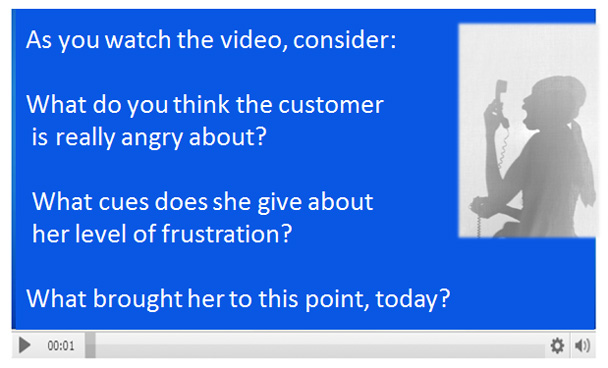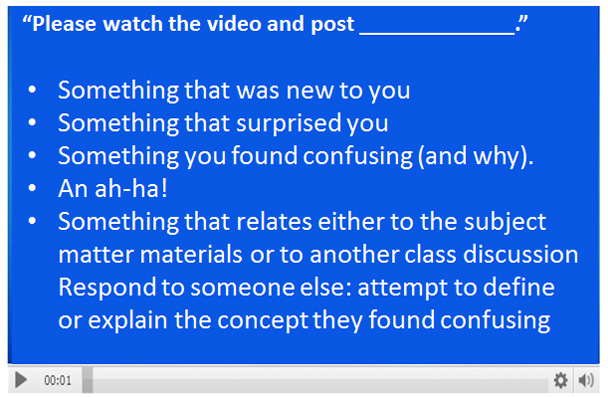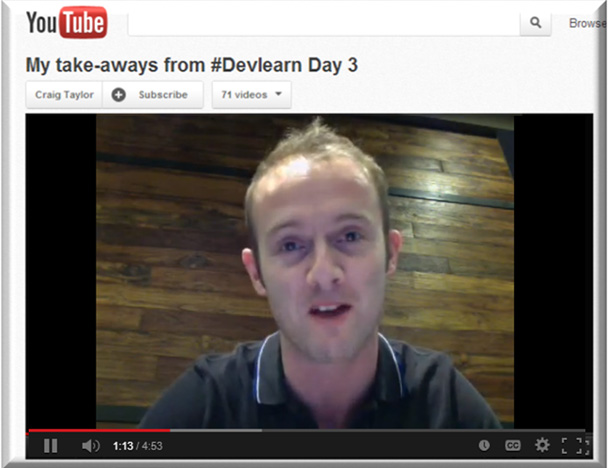Since the first filmstrip projector made its way into the first classroom, standup trainers have been incorporating video into formal instruction. In my experience, most actually do this pretty well: I’ve seen good use throughout my career of relevant video clips, points for discussion, and some conversation about what and why and comparison to that.
Video often made for good conversation and could reach the affective domain when other approaches did not. But when we moved to eLearning we left a lot of that behind—the video clips were part of the eLearning content, but the rest of that experience, the talking and processing, didn’t make the transition. With so many new avenues for delivering video online it’s a shame that we’re not doing a better job of capturing the things a good instructor in a good face-to-face setting can bring.
Set the stage
Prime the pump by helping learners understand why they’re watching this video, now. Give them behaviors to look for and actions to anticipate. Figure 1 shows an example, the introductory screen to a customer service video on dealing with angry callers.
 Figure 1: Video about angry callers alerts viewer to things to look
for
Figure 1: Video about angry callers alerts viewer to things to look
for
Realize: the longer the video, the more elements you are asking the learner to attend to. It’s easy to let settings, and outfits, and accents, and characters distract. Remember what Richard Mayer’s research on multimedia learning tells us: it’s important for those designing experiences to help the learner select what to attend to. Offering some pre-video cues will go a long way toward helping the viewer focus on what matters.
Want conversation?
If you want conversation, then give people something to talk about. If the tool comes with a chat or comment area—like YouTube’s—then leverage that space as a room for conversation rather than just comments. Or use the discussion-board feature of your LMS. Or use a Facebook group or a wiki or even a blog. Close the video with a screen asking for conversation that helps learners connect with existing knowledge and each other:
- What did the supervisor in the video do well?
- What would you do differently?
- How do you think the employee will respond?
- What should the supervisor do next?
Want critical thinking or reflection?
Ask learners to post their own reactions (Figure 2), especially around new ideas or new learning, as shown in Figure 2:
 Figure 2: Ask for viewer reactions to videos
Figure 2: Ask for viewer reactions to videos
The Teaching Channel uses space on its interface to post questions that encourage reflection. For instance, in “When a Lesson Goes Wrong,” teacher Sarah Brown Wessling walks viewers through an overview of a lesson plan that failed, then shows how she fixed it. The sidebar in the interface asks questions such as “What can you learn [from this video] about reflecting on your practice?”
Hand over the camera
Users, armed with phones equipped with video cameras, are increasingly comfortable with and adept at creating and sharing their own videos. Encourage them to be “social” in the sense of contributing to course materials and organizational communication. When the UK’s Craig Taylor (Figure 3) was the company’s sole employee sent to Las Vegas for DevLearn, he ended each day by capturing about five minutes’ worth of reflection about the experience: speakers he’d seen, an overview of key points, a few critical takeaways. In this way he was able to document his day, reflect on new learning, and share it with those back at the office.
 Figure 3: Craig Taylor reports from DevLearn
Figure 3: Craig Taylor reports from DevLearn
Even if learners don’t create the videos themselves, they can help filter, locate, and vet suggestions for updated or new additions to existing programs, or help build a library to support informal learning across the organization. Since we know people don’t argue with their own data, participating as a partner with L&D efforts will help shore up learner commitment.
Next time you’re working with deploying video online, step back and look for ways to help learners engage with it—and with each other—rather than only consume it.



